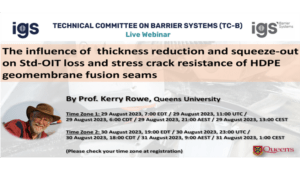TC-Barriers Webinar by Prof. Kerry Rowe: The influence of thickness reduction and squeeze-out on Std-OIT loss and stress crack resistance of HDPE geomembrane fusion seams

About the webinar:
The difference in seam squeeze-out antioxidant loss (in terms of standard oxidative induction time, Std-OIT loss) and thickness reduction are evaluated for three different 1.5 mm-thick high density polyethylene (HDPE) geomembranes (GMBs) seamed using a variety of welding parameters and two different wedge welders. Partial squeeze-out antioxidant loss was detected in seams created from each of the three materials examined, with the majority of the loss occurring when seam thickness reductions fell between 0.4 mm and 0.8 mm. This talk provides a rational basis for defining a practical 1.5 mm fusion seam thickness reduction criteria based on limiting antioxidant loss within a seam’s squeeze-out and also provides a framework for identifying potentially higher-risk fusion seams. Then the unnotched and notched stress crack resistance (SCR) of HDPE GMB) fusion seams is examined. Unnotched seam SCR specimens are shown to preferentially initiate craze formation at the terminating edge of the squeeze-out bead, while incorporating potentially degraded areas, such as the seams heat-affected zone (HAZ), within the slow crack growth region of the specimen. The average normalized seam SCR value (normalized with respect to the unnotched sheet SCR) was found to be 0.3 ± 0.1, or about 30% of the SCR of the unnotched sheet. It is shown that squeeze-out geometry can significantly affect the SCR of fusion seams. Deleterious squeeze-out geometries are identified. Finally, the accelerated aging of fusion welds in a 12-year old 1.5 mm HDPE GMB, which had experienced a decrease in Std-OIT from 135 to 87 min between manufacturing and welding, is examined. In general, individual aged seam SCR failure times fell between the notched and unnotched sheet, with adhered squeeze-out bead seams exhibiting individual failure times closer to the notched sheet and an average time until nominal failure (tNF) ~21-35% of that for unnotched sheet. Differences in tNF are attributed to residual stresses and/or accelerated craze formation in seams with adhered squeeze-out beads. Non-adhered squeeze-out seams exhibited a longer tNF, indicating a seam tNF less than that of the sheet may not be intrinsic to all HDPE fusion seams. The talk emphasizes the deleterious effect that squeeze-out adherence can have on seam SCR and time to nominal failure.
About the speaker:
Educated at the University of Sydney, Kerry Rowe worked with the Australian Government Department of Construction 8 years prior to immigrating to Canada. He spent 20 years as a professor at The University of Western Ontario, London, Canada. From 2000 to 2010, he served as Vice-Principal (Research) at Queen’s University in Kingston. Since 2010 he has held the Canada Research Chair in Geotechnical and Geoenvironmental Engineering at Queen’s where he is also the Barrington Batchelor Distinguished University Professor. His professional practice and research has covered a broad range of geotechnical and geoenvironmental engineering including extensive work on geotextiles, geomembranes, geogrids, geonets landfills, ponds, dams as well as reinforced embankments and walls. He is a past President of the International Geosynthetics Society, the Canadian Geotechnical Society and the Engineering Institute of Canada. He has been selected to present the world’s most prestigious named geotechnical lectures including the Giroud Lecture (2002), Rankine Lecture (2005), Karl Terzaghi Lecture (2017), and Mercer Lecture (2019). In 2013, the International Society for Soil Mechanics and Geotechnical Engineering created a named lecture to honour his pioneering contributions to geoenvironmental engineering, the ISSMGE R. Kerry Rowe Lecture. He has received numerous awards and been elected a a Distingished Member of ASCE (it hiighest award), Foreign Member of the US National Academy of Engineering, and a Fellow of the Royal Society (London, UK), UK Royal Academy of Engineering, the Royal Society of Canada, and the Canadian Academy of Engineering. He has been appointed an Officer of the Order of Canada (O.C.). The international Geosynthetics Society (IGS) Technical Committee on Barriers (TCB) has announced and started the Kerry Rowe lecture series since 2023 in recognition of his powerful contributions to the understanding of barrier behaviour and performance.
Registration
Time Zone 1: 29 August 2023, 7:00 EDT / 29 August 2023, 11:00 UTC / 29 August 2023, 6:00 CDT / 29 August 2023, 21:00 AEST / 29 August 2023, 13:00 CEST
Register for time zone 1: https://us06web.zoom.us/webinar/register/WN_bKboHSzgTQq1A_njKXeYjg
Time Zone 2-Repeat session: 30 August 2023, 19:00 EDT / 30 August 2023, 23:00 UTC / 30 August 2023, 18:00 CDT / 31 August 2023, 9:00 AEST / 31 August 2023, 1:00 CEST
Register for time zone 2: https://us06web.zoom.us/webinar/register/WN_rAD4-JffRZuS2emMqRtigA


















